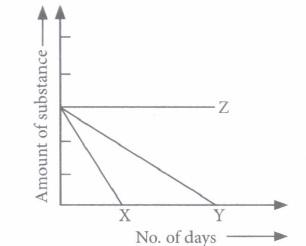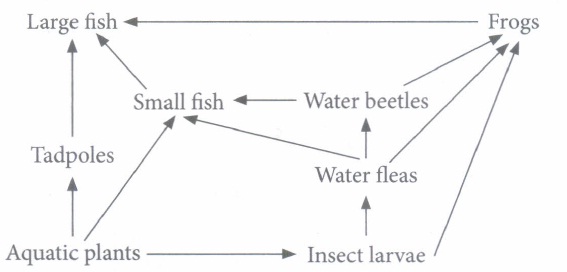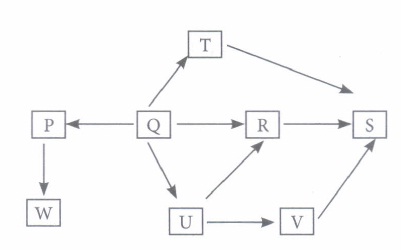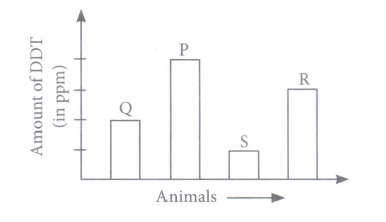CBSE 10th Standard Science Subject Our Environment Chapter Case Study Questions With Solution 2021
By QB365
QB365 Provides the updated CASE Study Questions for Class 10 , and also provide the detail solution for each and every case study questions . Case study questions are latest updated question pattern from NCERT, QB365 will helps to get more marks in Exams
QB365 - Question Bank Software
CBSE 10th Standard Science Subject Our Environment Case Study Questions With Solution 2021
10th Standard CBSE
-
Reg.No. :
Science
-
Advancement of the technology has resulted in improvement of our lifestyle and has also changed our attitude. When the human population was low and technology was in its infancy, the various kinds of solid wastes generated due to human activities were easily degraded by decomposers present in nature and it did not create any Significant harmful effect on the environment. In the recent times, however human population has increased tremendously and the technology has become greatly advanced. These two factors have contributed Significantly in the deterioration of our environment due to addition of number of wastes.
(i) Samaira took three different types of solid wastes P,Q, R and buried them under the soil in a pot, as she wanted to study their rate of decomposition. Her findings are shown in the given graph

Select the option that correctly identifies P, Q and RP Q R (a) Polythene bag Leather bag Fruit peel (b) Used syringes Broken glass Leather purse (c) Cardboard Cow dung Rubber mat (d) Human excreta Paper cup Cow dung (ii) Which of the following statements regarding solid wastes is correct?
(a) Change in the packaging technology has resulted in generation of lot of solid wastes.
(b) Dumping of solid wastes could reduce the fertility of the soil leading to reduction in crop yield.
(c) Accumulation of solid waste could cause increased incidents of disease in a locality.
(d) All of these
(iii) Teacher kept few solid wastes in her class as givenJute bag (I), Tube light (II), Aluminium (oil (III), Paper cup (IV), Fruits (V), Glass tumbler (VI), Hedge trimming (VII), Plastic bag (VIII), Metal keys (IX), DDT (X) She asked students to arrange them in group A (Biodegradable) and group B (Non-biodegradable). Select the student that has grouped the items correctly.
(a) Tarun - Group A: I, IV, V,VII, Group B : II, III, VI, VIII, IX, X (b) Shivani - Group A : I, III, V,VII, X Group B : II, IV, VI, VIII, IX (c) Neha - Group A: II, III, IV, V, IX Group A: II, III, IV, V, IX (d) Advait - Group A : I, III, IV, V,X Group B : II, VI, VII, VIII, IX (iv) Select the option that incorrectly matches the type of solid waste and its correct disposal system
(a) Plastic bottle - Send for recycling
(b) Used tea leaves and kitchen waste - Collect in a pit to form compost
(c) Used syringes and needle - Wash and reused
(d) Municipal solid waste and fecal sludge - Buried in low lying areas to level uneven surface of land
(v) Given graph shows time taken by different types of materials to decompose.

Which of the following substances could be anon-biodegradable material?(a) X (b) Y (c) Z (d) None of these (a) -
In any given ecosystem, all living organisms are linked in a systematic chain with respect to their mode of manufacturing food/feeding habits. This sequential interlinking of organisms involving transfer of food energy from producers through a series of organisms with repeated eating and being eaten is called the food chain. A food chain may have 3-4 trophic levels.
(i) Which of the following statements regarding food chain is incorrect?
(a) It is a single straight pathway through which food energy travels in the ecosystem.
(b) It adds adaptability and competitiveness to the organisms.
(c) Presence of isolated food chains adds to instability of the ecosystem.
(d) Food chain binds up inorganic nutrients of the ecosystem.
(ii) Consider the following food chain.
Grass \(\longrightarrow\)A \(\longrightarrow\)Frog \(\longrightarrow\) Snake\(\longrightarrow\)Eagle
Which of the following can be placed at A?(a) Grasshopper (b) Rabbit (c) Phytoplankton (d) Rat (iii) Select the correct food chain.
(a) Aquatic plants \(\longrightarrow\) Tadpole \(\longrightarrow\)Water beetle\(\longrightarrow\)Pike\(\longrightarrow\)Perch
(b) Grass\(\longrightarrow\)Grasshopper\(\longrightarrow\)Snake\(\longrightarrow\) Frog\(\longrightarrow\) Eagle
(c) Grass\(\longrightarrow\) Rabbit\(\longrightarrow\) Wild cat\(\longrightarrow\) Tiger
(d) Zooplankton \(\longrightarrow\) Phytoplankton \(\longrightarrow\)Small fish\(\longrightarrow\)Fish
(iv) Food chains are sustained by producers and _____________.(a) herbivores (b) carnivores (c) omnivores (d) decomposers (v) Select the incorrect statement.
(a) Food chain may terminate at level of herbivore
(b) Food chain is always straight
(c) Food chain may have 3-5 trophic levels
(d) In a food chain, 80 to 90% of potential energy is lost as heat, at each transfer(a) -
Alternatives are always available in nature which results in a sort of interlocking pattern or food web. For instance, if a particular species of producers get destroyed by a disease in an ecosystem, herbivores of that area can feed on other species. Also in a food web, any given species may operate simultaneously at more than one trophic level
(i) Refer to the given food web.

What will be the effect on the food web if population of water fleas get eliminated?
(a) Population of water beetles will increase.
(b) Population of insect larvae will remain unaffected.
(c) Population of small fish will decrease.
(d) Population of frog will increase.
(ii) In the given food web, which organism operates at both primary and tertiary consumer level?(a) Small fish (b) Frog (c) Water fleas (d) Tadpole (iii) Refer to the given food web.

Which of the following statement the given food web is correct?
(a) When population of U decreases, population of R ants regarding nd V will increase.
(b) When population of Q decreases, population of R, T and U will increase.
(c) When population of R increases, population of S will increase.
(d) When population of S increases, population of R, T and U will also increase.
(iv) Which of the following statements is correct?
(a) Food webs provide alternative pathways of food availability.
(b) Greater alternatives available in a food web make the ecosystem more stable.
(c) Food webs also help in ecosystem development.
(d) All of these
(v) Food webs make a natural ecosystem ____________ than an man-made ecosystem(a) unstable (b) stable (c) variable (d) inconsistent (a) -
Some harmful non-biodegradable chemicals, i.e., pesticides (e.g., DDT) and heavy metals (e.g., mercury, arsenic cadmium, etc.) enter the bodies of organism through the food chain and go on concentrating at each trophic level. This phenomenon is called bio-magnification or biological magnification.
(i) Refer to the given food chain
Phytoplankton \(\longrightarrow\) Zooplankton \(\longrightarrow\)Small fish \(\longrightarrow\) Large fish\(\longrightarrow\)Fish eating birds
If concentration of DDT in small fish is estimated to be 0.5 ppm, then amount of DDT in zooplankton and large fish would respectively be(a) 0.04 ppm, 2ppm (b) 2 ppm, 0.04 ppm (c) 0.04 ppm, 0.04 ppm (d) 2 ppm, 0.5 ppm. (ii) Refer to the given table.
Organism Amount of cadmium A 0.5 ppm B 25ppm C 0.003 ppb D 2ppm E 0.04ppm According to the given data. The correct order in a food chain will be
(a) E\(\rightarrow\)C\(\rightarrow\)D\(\rightarrow\)A\(\rightarrow\)B (b) B\(\rightarrow\)D\(\rightarrow\)A\(\rightarrow\)E\(\rightarrow\)C (c) C\(\rightarrow\)E\(\rightarrow\)A\(\rightarrow\)D\(\rightarrow\)B (d) C\(\rightarrow\)E\(\rightarrow\)A\(\rightarrow\)B\(\rightarrow\)D (iii) A group of scientists analysed samples of five different animals from a river for possible accumulation of DDT in their body due to bio-magnification. The result obtained is shown in the given graph.
The correct order of the food chain operating in a river is

(a) S\(\rightarrow\)P\(\rightarrow\)Q\(\rightarrow\)R (b) S\(\rightarrow\)Q\(\rightarrow\)R\(\rightarrow\)P (c) P\(\rightarrow\)R\(\rightarrow\)Q\(\rightarrow\)S (d) P\(\rightarrow\)Q\(\rightarrow\)S\(\rightarrow\)R (iv) Higher amount of DDT disturb calcium metabolism of birds. This results in
(a) thickening of their egg shells (b) premature breaking of eggs (c) death of their embryos (d) both (b) and (c) (v) When animals are sprayed with poisons, they may die immediately, but their bodies still contain the poison. The poison in their bodies will then be passed on to the animals which eat them. What would be the consequence of a mass poisoning of the rabbit population in a grazing food chain and why?
(a) Plants would die quickly as they are eaten by rabbits
(b) Grasshopper would die quickly as all the animals in the food web would be affected
(c) Western rattlesnakes would quickly become poisoned as they eat rabbits
(d) Hawk would become poisoned as they feed on rabbits(a) -
Ozone layer is present in the earth's atmosphere. It is in the form of a protective shield. It contains three oxygen atoms (O3) which are formed as a consequence of photochemical reactions in the environment. Ozone absorbs harmful ultraviolet radiations of the sun. In this way, it protects all living beings on the earth. The thinning of ozone layer due to various human activities allows more UV radiations to pass through it which leads to harmful effects on man, animals and plants.
(i) Ozone layer is present in which layer of the atmosphere?(a) Troposphere (b) Mesosphere (c) Stratosphere (d) Thermosphere (ii) Enhanced UV-radiations would affect humans and other animals causing
(a) skin cancer
(b) blindness and increased chances of cataract in eyes
(c) malfunctioning of the immune system
(d) all of these
(iii) Read the given statements regarding ozone.
I. Ozone hole was first discovered over Montreal in 1976.
II. Ozone is a result of photochemical reactions in which starting molecule is oxygen.
III. Harmful chemicals produce active chlorine in presence of UV radiations, that destroys ozone layers.
IV. Ozone absorbs UV-radiations in the range of 800 - 1100 A.
Select the option that correctly identifies them as true (T) and false (F).I II III IV (a) F T T F (a) F F T T (c) T T F F (d) T F T T (iv) Which of the following are related to depletion of ozone layer?
(a) Chlorofluorocarbons (b) Halons (c) Carbon tetrachloride (d) All of these (v) Refer to the given events regarding thinning of ozone layer and arrange them in a sequence.
I. Active chlorine is produced in presence of UV radiations.
II. CFCs are released in the air.
III. Ozone layer in the stratosphere become thin.
IV. CFCs enter from troposphere into stratosphere.
V. Use of CFCs in refrigerators and air conditioners as coolants.
VI. Active chlorine destroy ozone by converting it into oxygen.(a) V \(\rightarrow\) II \(\rightarrow\) I \(\rightarrow\) VI\(\rightarrow\)IV \(\rightarrow\) III (b) V \(\rightarrow\) II \(\rightarrow\) IV \(\rightarrow\)I \(\rightarrow\)VI \(\rightarrow\) III (c) V\(\rightarrow\) I \(\rightarrow\) II \(\rightarrow\) III\(\rightarrow\)VI \(\rightarrow\) IV (d) V \(\rightarrow\) IV\(\rightarrow\) II \(\rightarrow\)I \(\rightarrow\) III \(\rightarrow\) VI (a)


















